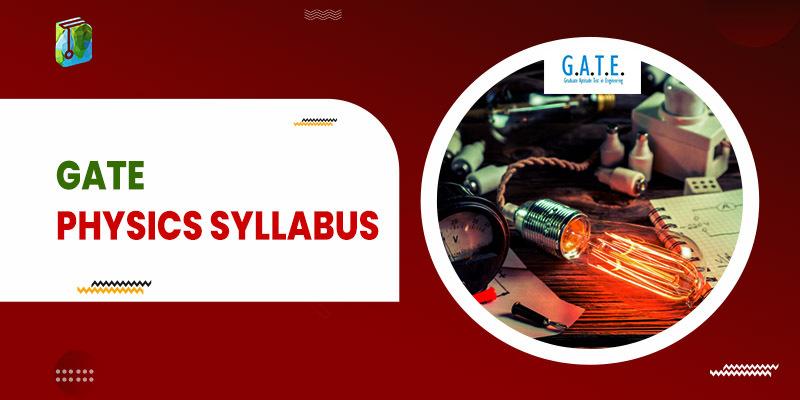Physics is one of the core branches of engineering and technology. It makes the base for the engineering branches. IIT Guwahati is the conduction authority of the GATE examination. The conducting authority has released the GATE Syllabus along with the official notification.
This article will give you complete information regarding the GATE Physics Syllabus 2024.
GATE Physics Syllabus 2024
GATE Physics Syllabus consists of the topics like Mathematical Physics, Classical Mechanics, Electromagnetic Theory, Quantum Mechanics, Thermodynamics and Statistical Physics, Atomic and Molecular Physics, Solid State Physics & Electronics, and Nuclear and Particle Physics.
Section 1: Mathematical Physics
Linear vector space: basis, orthogonality and completeness; matrices; vector calculus; linear differential equations; elements of complex analysis: Cauchy-Riemann conditions, Cauchy’s theorems, singularities, residue theorem and
applications; Laplace transforms, Fourier analysis; elementary ideas about tensors: covariant and contravariant tensor, Levi-Civita and Christoffel symbols.
Section 2: Classical Mechanics
D’Alembert’s principle, cyclic coordinates, variational principle, Lagrange’s equation of motion, central force and scattering problems, rigid body motion; small oscillations, Hamilton’s formalisms; Poisson bracket; special theory of
relativity: Lorentz transformations, relativistic kinematics, mass‐energy equivalence.
Section 3: Electromagnetic Theory
Solutions of electrostatic and magnetostatic problems including boundary value problems; dielectrics and conductors; Maxwell’s equations; scalar and vector potentials; Coulomb and Lorentz gauges; Electromagnetic waves and their reflection, refraction, interference, diffraction and polarization; Poynting vector, Poynting theorem, energy and momentum of electromagnetic waves; radiation from a moving charge.
Section 4: Quantum Mechanics
Postulates of quantum mechanics; uncertainty principle; Schrodinger equation; one-, two- and three-dimensional potential problems; particle in a box, transmission through one-dimensional potential barriers, harmonic oscillator, hydrogen atom; linear vectors and operators in Hilbert space; angular momentum and spin; addition of angular momenta; time-independent perturbation theory; elementary scattering theory.
Section 5: Thermodynamics and Statistical Physics
Laws of thermodynamics; macrostates and microstates; phase space; ensembles; partition function, free energy, calculation of thermodynamic quantities; classical and quantum statistics; degenerate Fermi gas; black body radiation and Planck’s distribution law; Bose‐Einstein condensation; first and second-order phase transitions, phase equilibria, critical point.
Section 6: Atomic and Molecular Physics
Spectra of one‐ and many‐electron atoms; LS and JJ coupling; hyperfine structure; Zeeman and Stark effects; electric dipole transitions and selection rules; rotational and vibrational spectra of diatomic molecules; electronic transition in diatomic molecules, Franck‐Condon principle; Raman effect; NMR, ESR, X-ray spectra; lasers: Einstein coefficients, population inversion, two and three-level systems.
Section 7: Solid State Physics & Electronics
Elements of crystallography; diffraction methods for structure determination; bonding in solids; lattice vibrations and thermal properties of solids; free electron theory; band theory of solids: nearly free electron and tight-binding models; metals, semiconductors, and insulators; conductivity, mobility, and effective mass; optical, dielectric and magnetic properties of solids; elements of superconductivity: Type-I and Type II superconductors, Meissner effect, London equation. Semiconductor devices: diodes, Bipolar Junction Transistors, Field Effect Transistors;
operational amplifiers: negative feedback circuits, active filters and oscillators; regulated power supplies; basic digital logic circuits, sequential circuits, flip‐flops, counters, registers, A/D and D/A conversion.
Section 8: Nuclear and Particle Physics
Nuclear radii and charge distributions, nuclear binding energy, Electric and magnetic moments; nuclear models, liquid drop model: semi‐empirical mass formula, Fermi gas model of the nucleus, nuclear shell model; nuclear force and two nucleon problem; alpha decay, beta‐decay, electromagnetic transitions in nuclei; Rutherford scattering, nuclear reactions, conservation laws; fission and fusion; particle accelerators and detectors; elementary particles, photons, baryons, mesons, and leptons; quark model.
Conclusion
Physics is one subject that challenges every student. There are a lot of complex theories and derivations involved in Physics. The students must figure out their weak and strong areas and work accordingly.
Candidates are suggested to appear for the mock tests frequently to analyze their preparation. Along with the studies, do not neglect your health.
Good luck with all your future endeavors!
People are also reading:

